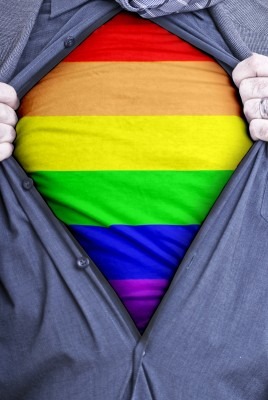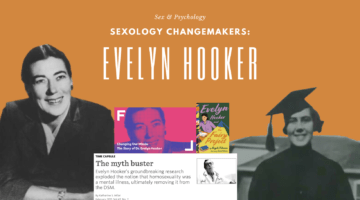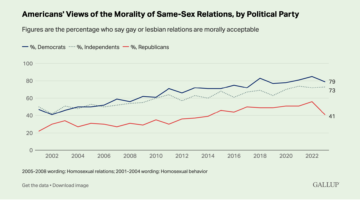How Accurate Is “Gaydar?”
November 21, 2012 by Justin Lehmiller
Gaydar refers to the ability to categorize people as gay or straight on the basis of indirect information (e.g., a person’s speech patterns or movement). Gaydar is used by people of all sexualities for a variety of purposes. For instance, gays and lesbians may use it to decode flirtation, whereas heterosexual persons may simply use it to figure out who’s who. So how good are people at making these categorizations and what it is that people are actually paying attention to? A recent set of studies published in the Archives of Sexual Behavior indicates that gaydar judgments are reasonably accurate, and that judgments of sexuality are linked to sex role stereotypes [1].
Study 1 investigated the accuracy of gaydar and considered whether gay or straight people are better at it. To accomplish this, participants of varying sexualities were given information about a target person and asked to identify the target’s sexual orientation. The information provided was drawn from videos of heterosexual and homosexual men and women who had been filmed talking about their interests. Using film-editing software, researchers created several different types of stimuli that isolated specific types of information. This allowed the scientists to see whether certain cues were more influential than others. For each target, participants were therefore presented with one of the following four cues: (1) a high contrast, black-and-white video clip without sound that emphasized the target’s movement and posture, (2) an audio-only clip that revealed the target’s speech patterns and voice pitch, (3) a still photograph that captured the target’s overall appearance, or (4) a typewritten transcript of the target’s interests.
Overall, participants had pretty good gaydar. Results indicated that 75% of gay targets and 87% of straight targets were categorized accurately. If people were making chance decisions, they should have only been correct about 50% of the time, so it is clear that people can detect sexuality at a level that far exceeds chance. Moreover, there were no clear differences in accuracy among participants of different genders and sexual orientations, which indicates that this ability is not specific to any one group. In terms of the type of information that was most influential in participants’ decisions, it appeared that physical appearance and speech were the most important components.
Study 2 examined the extent to which gaydar judgments were correlated with ratings of sex typicality/atypicality. The study’s materials and procedures were identical to Study 1—the only difference was that instead of guessing each target’s sexual orientation, participants rated how masculine and feminine each target was based upon the stimuli they received. These ratings were then correlated with the sexual orientation judgments made in the first study. Across all types of information (movement, speech, appearance), those targets that were judged most atypical of their sex were the most likely to be categorized as gay, while those targets judged most typical of their sex were most likely to be categorized as straight. In other words, the men who were seen as most masculine and the women seen as most feminine in Study 2 were usually labeled straight in Study 1; in contrast, men who were more feminine and women who were more masculine were usually labeled gay. This suggests that in trying to categorize people as gay vs. straight, people may be paying attention to who conforms to sex role stereotypes.
Of course, there are some important limitations of this research. For one thing, all of the videotaped targets were recruited in Chicago, a liberal city with a very visible and active gay community. Thus, the targets may not necessarily be representative of the gay and lesbian population at large. Also, given that all of the raters came from Chicago as well, perhaps they had more familiarity with non-heterosexuals, thereby inflating the accuracy of their gaydar. Moreover, participants had a forced choice sexuality judgment (i.e., they could only select heterosexual OR homosexual); however, in the real world, there are more sexual orientations than this (bisexuality anyone?). If participants were presented with the full range of choices, they might not be as accurate.
Nonetheless, these studies reveal that gaydar definitely exists and that while it is certainly not perfect, it tends to be fairly accurate. Additionally, there are many pieces of information that may reveal a person’s sexuality. Although these results suggest that sexual orientation judgments may be a function of sex-role stereotypes (i.e., the idea that gay men have some feminine characteristics and lesbians have some masculine characteristics), it is important to note that while the average target did seem to conform to the stereotypes, this was not universally true. Some gay men are extremely masculine, while some straight men are very feminine, just as some lesbians are extremely feminine and some straight women are very “butch.” Because of this diversity, gaydar is not 100% accurate. As a result, it would be wise not to make any important decisions based only upon a stereotype.
Want to learn more about The Psychology of Human Sexuality? Click here for a complete list of articles or like the Facebook page to get articles delivered to your newsfeed.
[1] Rieger, G., Linsenmeier, J. A. W., Gygax, L., Garcia, S., & Bailey, J. M. (2010). Dissecting “gaydar”: Accuracy and the role of masculinity-feminity. Archives of Sexual Behavior, 39, 124-140. doi: 10.1007/s10508-008-9405-2
Image Source: 123rf.com
Related Articles:

Dr. Justin Lehmiller
Founder & Owner of Sex and PsychologyDr. Justin Lehmiller is a social psychologist and Research Fellow at The Kinsey Institute. He runs the Sex and Psychology blog and podcast and is author of the popular book Tell Me What You Want. Dr. Lehmiller is an award-winning educator, and a prolific researcher who has published more than 50 academic works.
Read full bio >


